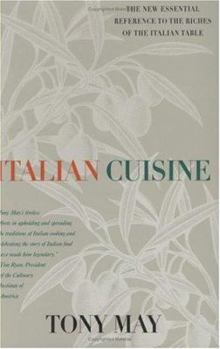Italian Cuisine: An Essential Reference with More than 300 Recipes
The new bible of authentic Italian cuisine from one of the world's leading experts U ntil recently, the true complexity of Italian cuisine was unknown. Now, restauranteur Tony May presents a comprehensive cookbook that celebrates Italy's authentic gastronomic pleasures. In chapters devoted to breads, antipasti, sauces, meats, vegetables, soups, pasta, fish, poultry, cheeses, and desserts, never-before-published traditional recipes show the breadth of Italian cuisine: -Chisolini-flaky fried dough served with antipasti -Zucchini blossom soup -Crisp fried polenta with borlotti beans and cabbage -Pappardelle with wild hare sauce -Christmas capon stuffed with walnuts -Ligurian seafood caponota -Tortelli de Carnevale-sweet, puffy fried beignets. In addition to the many recipes, a comprehensive Italian to English glossary of food terms provides a cook's quick reference. Throughout, May's inimitable native Italian voice guides the cook's hands in a book destined to become a standard volume on the cookbook shelf.
Format:Hardcover
Language:English
ISBN:0312302800
ISBN13:9780312302801
Release Date:June 2005
Publisher:St. Martin's Press
Length:334 Pages
Weight:1.45 lbs.
Dimensions:1.1" x 6.4" x 9.5"
Customer Reviews
3 ratings
Italian Cuisine
Published by Thriftbooks.com User , 16 years ago
Great book well informed on the Italian food scene. Tony has the cooks edge on Italian fare.
Great Resource
Published by Thriftbooks.com User , 19 years ago
I would call this book "Italian Cooking Beyond Pasta" - it is a wonderful compendium of genuine recipes in all categories from every corner of Italy. A delight to browse and to cook from.
Excellent Text on Professional Italian Cuisine. Buy It!
Published by Thriftbooks.com User , 19 years ago
`Italian Cuisine (2nd Edition)' by Restaurateur, Tony May ranks as one of the best books on the general subject of Italian cuisine as a whole. Good books on Italian cooking come in all different flavors. There are the great recipe collections such as Michele Scicolone's `1000 Italian Recipes' and Mario Batali's `Molto Italiano'. There are the studies of regional cuisines such as Lydia Bastianich's book on Istrian cuisine, `La Cucina di Lydia' and Lynne Rosetto Casper's excellent study of Emilia-Romagna, `The Splendid Table'. There are the surveys of all Italian regions, as in the classic Claudia Roden book, `The Food of Italy' and a book of the same name by Waverley Root, not to mention the classic by Elizabeth David. There are analytic books on Italian ingredients such as Erica De Mane's `The Flavors of Southern Italy'. There are treatises on styles of Italian cooking such as Susan Hermann Loomis' `Italian Farmhouse Cooking', Patricia Wells' `Trattoria', and Joyce Goldstein's `Enoteca'. There are books of Italian vegetable cooking such as the excellent volumes by Jack Bishop and Faith Willinger. There are dictionaries, such as Antonio Carluccio's `Complete Italian Food' and Anna Del Conte's `the Concise Gastronomy of Italy'. And, let us not forget the Italian-American books such as John Mariani's `The Italian-American Cookbook'. Not to be excluded are culinary memoirs, such as Vincent Schiavelli's `Many Beautiful Things' and other volumes on Sicilian cooking. This litany of book subjects and titles is simply to distinguish Mr. May's book from all these others. His volume is neither complete nor regional nor personal nor vegetarian nor encyclopedic nor American nor analytical. Its primary focus is on classic recipes and cooking methods. It is very important to note very early in the book the statement that this book was written for culinary professionals. Thus, although it is packed with interesting tips and techniques, the presentation of the methods do assume you know your way around a kitchen. For example, unlike excellent illustrated instructions on pasta making in books by Lydia Bastianich and Marcella Hazan; the techniques presented here are all done without `visual aids'. This is entirely fair, as the book has declared itself a manual for professionals who already know the basics of mixing dough. While the book does not make the mistake of saying it is `complete'; it does describe itself as an `essential reference to the riches of the Italian table'. I am convinced that no book on a subject so rich as Italian cuisine can cover everything. Therefore, the best books limit their focus to a particular part of the beast and one hopes they don't make any mistakes. While I still feel this is an excellent book for serious foodies, I did find several statements that seemed mistaken to me. One was the translation of `antipasto' as `before the meal' rather than `before the pasta course', another was the classification of pine nuts and pistachio n





